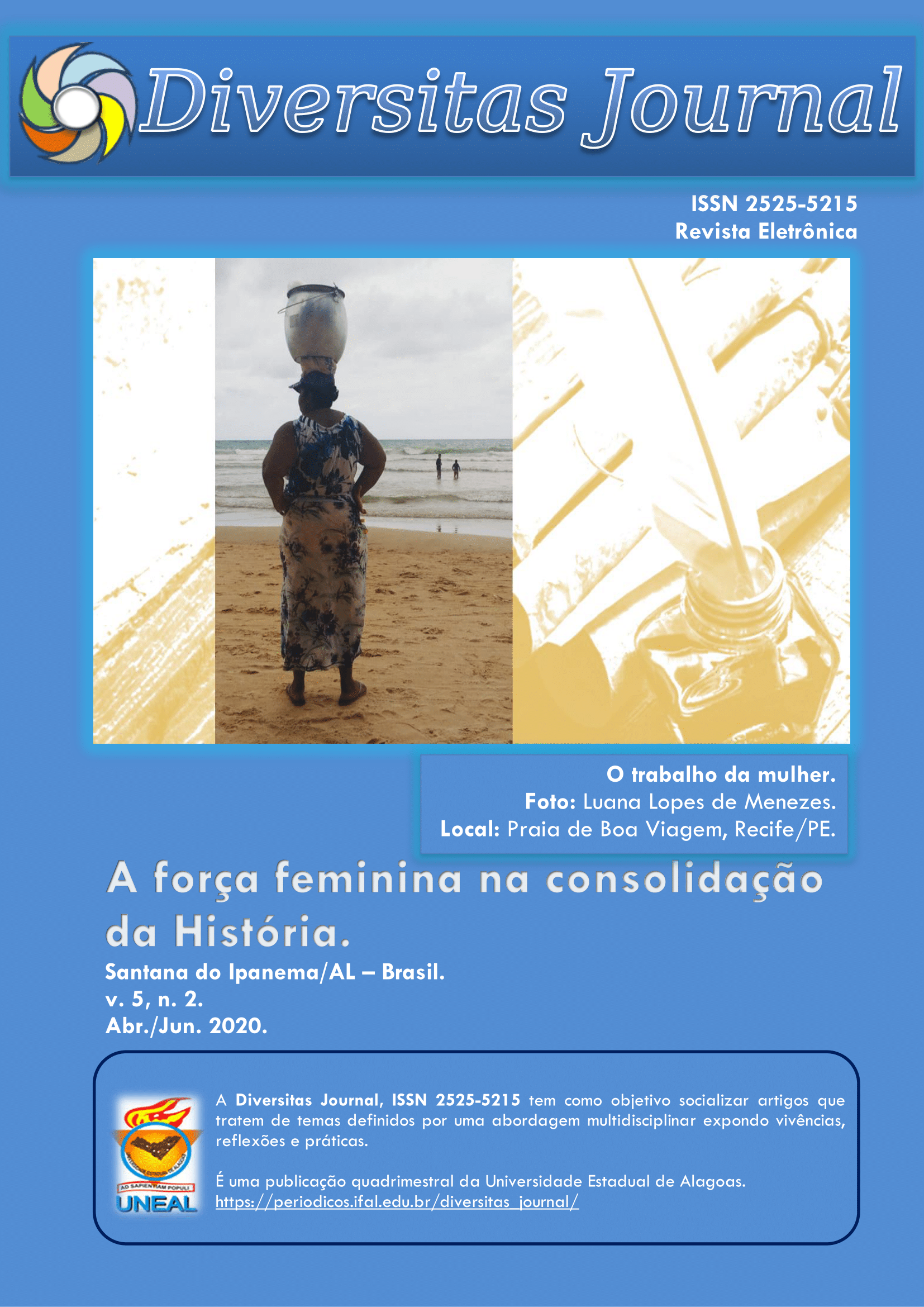Saúde na Escola: a abordagem de educadores sobre as ectoparasitoses em duas escolas públicas do município de Murici, Alagoas
DOI:
https://doi.org/10.17648/diversitas-journal-v5i2-678Abstract
ABSTRACT: The parasites that inhabit the human integumentary system are called ectoparasites, being responsible for causing ectoparasitárias diseases. These are usually recurring diseases in children and adolescents of school age. In order to determine an initial diagnosis about the problems in our environment, this study developed through the vision of educators (teachers and administrators) of two elementary municipal schools of Murici-AL, and order check, some Myths linked to the basic concepts, as well as the song is worked in the school. For this we used a data collection instrument, represented by a questionnaire to teachers, containing objective questions about various aspects of the various ectoparasitoses. As direct benefits, was handed a pamphlet of educational awareness about the major ectoparasites with basic information about the life cycle, transmission and treatment. It was found that 31% of educators consider the ectoparasitoses as a public health problem, and 97% say be the pediculosis and scabies the best-known ectoparasitoses. 70, 60 and 50% of educators, respectively, were Larva Migrans Cutanea, Tungiase and Myiasis. With respect to pediculosis, 52% make the diagnosis and communicated to the responsible. As for the myths of pediculosis, 14% think the transmission involves animals; 79% think that the school is not a source of infestation; 86% think the transmission is related exclusively to the socioeconomic factor and 21% agree that the lice jump or fly. We identified the existence of many questions and myths about the thematic work, being imperious need of addressing the topics of health education, as calls for the national curricular parameters (PCNs), so that students to achieve better quality of life and can enjoy a physical, mental and social development healthy for a full educational performance.
KEYWORDS: Ectoparasitoses, pediculosis in schools, health education.
Metrics
References
Heukelbach J. Tungíase. Rev. Inst. Med. trop. S. Paulo, 2005; 47(6): 307-313.
Heukelbach J, Franck S, Feldmeier H. Therapy of tungiasis: a double-blinded randomized controlled trial with oral ivermectin. Mem Inst Oswaldo Cruz, 2004; 99(8): 873-876.
Heukelbach J, van Haeff E, Rump B, Wilcke T, Moura RC, Feldmeier H. Parasitic skin diseases: health care-seeking in a slum in north-east Brazil. Trop Med Int Health, 2003; 8(4):368-73.
Linardi PM. Anoplura. In: Parasitologia Humana (Neves DP, Melo AL, Genaro O, Linardi PM), pp. 368-372, São Paulo: Editora Atheneu, 2002.
Brasil. Secretaria de Educação Fundamental. Parâmetros curriculares nacionais : meio ambiente, saúde / Secretaria de Educação Fundamental. – Brasília : 128p, 1997.
Borges-Moroni R, Nunes SCB, de Souza RBA, Mendes J, Moroni FT. O conhecimento de cuidadores e cabelereiros sobre aspectos epidemiológicos da pediculose da cabeça em Manaus, AM, Brasil. Scientia Amazonia, 2015; 4(2):60-65.
Goldschmidt AI, Loreto E. Investigação das concepções espontâneas sobre pediculose entre pais, professores, direção e alunos de educação infantil e anos iniciais Revista Electrónica de Enseñanza de las Ciencias, 2012; 11 (2): 455-470.
Gabani FL, Maebara CML, Ferrari RAP. Pediculose nos centros de educação infantil: conhecimentos e práticas dos trabalhadores. Esc Anna Nery Rev Enferm, 2010; 14 (2): 309-317.
Carvalho TF, Ariza L, Heukelbach J, Silva JJ, Mendes J, Assis e Silva A, Limongi JE. Conhecimento dos profissionais de saúde sobre a situação da tungíase em uma área endêmica no município de Uberlândia, Minas Gerais, Brasil, 2010. Epidemiol. Serv. Saúde, Brasília, 2012; 21(2): 243-251.
IBGE – Instituto Brasileiro de Geografia e Estatística. Censo Demográfico 2010.
Campelo Júnior EB, Calheiros CML, Soares VL, Jackson NA, Heukelbach J. Status Ectoparasitário da Tungíase em Área Hiperendêmica no Estado de Alagoas. In Congresso Pan Americano de Parasitologia, UFRS, 2006. 2-11p.
Wilcke T. et al.; In. Heukelbach J, Oliveira FAS, Feldmeier H. Ectoparasitoses e saúde pública no Brasil: desafios para controle. Cad. Saúde Pública, 2003; 19(5): 1535-1540.
Souza PAT. Pediculose na escola: uma oportunidade para aprender e ensinar. Trabalho de Conclusão de Curso. Universidade Estadual Paulista Júlio de Mesquita Filho, 2008.
Elgart ML, Higdon RS. Canine scabies: report of a family outbreak. Sth. med. J.,65:375-6, 1972.
Downloads
Published
How to Cite
Issue
Section
License
Copyright (c) 2020 THIAGO JOSE MATOS ROCHA

This work is licensed under a Creative Commons Attribution 4.0 International License.
The Diversitas Journal expresses that the articles are the sole responsibility of the Authors, who are familiar with Brazilian and international legislation.
Articles are peer-reviewed and care should be taken to warn of the possible incidence of plagiarism. However, plagiarism is an indisputable action by the authors.
The violation of copyright is a crime, provided for in article 184 of the Brazilian Penal Code: “Art. 184 Violating copyright and related rights: Penalty - detention, from 3 (three) months to 1 (one) year, or fine. § 1 If the violation consists of total or partial reproduction, for the purpose of direct or indirect profit, by any means or process, of intellectual work, interpretation, performance or phonogram, without the express authorization of the author, the performer, the producer , as the case may be, or whoever represents them: Penalty - imprisonment, from 2 (two) to 4 (four) years, and a fine. ”


















